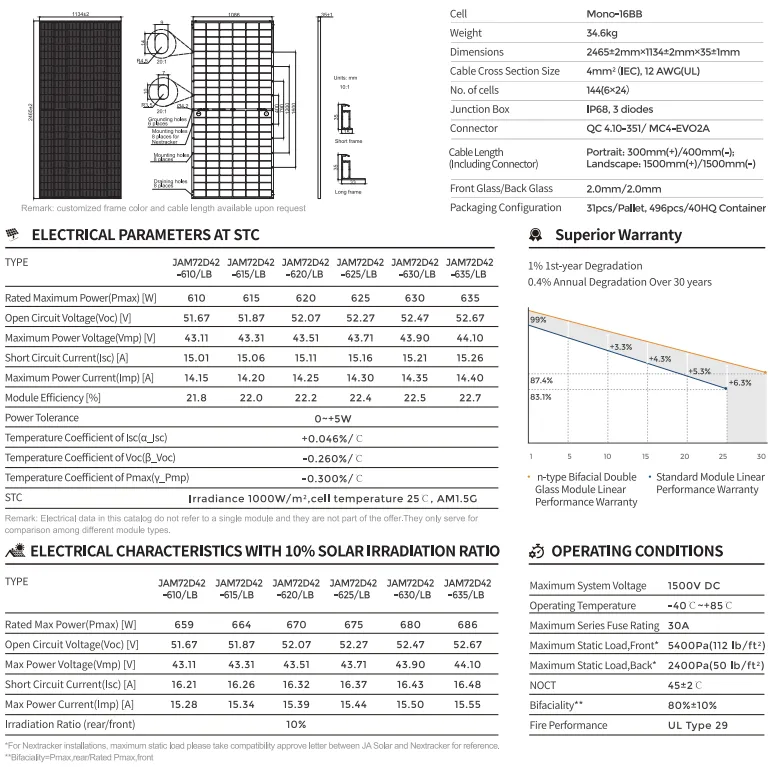Typical dimensions of solar panels for home and commercial use
Understanding the Normal Solar Panel Size
As the world shifts towards renewable energy sources, solar power has emerged as one of the most prominent technologies used for harnessing solar energy
. However, for homeowners and businesses contemplating the switch to solar energy, understanding the normal solar panel size is a critical factor that influences both installation and efficiency.Typically, a standard solar panel measures around 65 inches by 39 inches, which translates to approximately 17.5 square feet. This size is common among most residential solar panels and is designed to generate between 250 to 400 watts of power. The variances in power output are mainly due to the panel's efficiency and the technology used in manufacturing it, such as monocrystalline or polycrystalline.
Monocrystalline solar panels are known for their higher efficiency and durability but typically come at a higher price point. They provide more power output per square foot compared to their polycrystalline counterparts, which tend to be less efficient and require more space to produce the same amount of energy.
When considering solar panel installation, it is vital to assess the rooftop space available. A standard residential solar energy system typically consists of 20 to 25 panels, translating to a space requirement of about 350 to 450 square feet for installation. However, this can vary based on the household’s energy needs, the efficiency of the panels, and the orientation and angle of the roof.
normal solar panel size

Another important aspect to consider is how much energy a household or facility consumes. The average U.S. household uses about 877 kWh per month, which equates to an average daily use of about 29 kWh. To meet this demand, homeowners might require a solar energy system capable of generating approximately 7 to 10 kWh per day, depending on factors such as location, climate, and solar panel efficiency.
Moreover, the solar irradiance in a specific geographical area plays a significant role in determining the overall size and number of panels needed. Regions with higher sunlight exposure will require fewer panels to achieve the same energy output as areas with less sunlight. For instance, a home in Arizona requires fewer solar panels than one located in Seattle to generate an equivalent amount of energy.
It is also essential to discuss the weight and structural implications of solar panel installation. A standard solar panel weighs between 40 to 50 pounds, and the total weight of multiple panels can add significant load to your roof. It is advisable to consult with a professional installer to ensure that pre-existing structures can support the additional weight and that your roof is suitable for installation.
Lastly, it is worth noting that solar panel sizes and technologies continue to evolve. Larger panels are being produced, which aim to increase efficiency while reducing material use. Innovations in solar technology might lead to the emergence of compact panels with greater power output, allowing for reduced physical footprint.
In conclusion, understanding normal solar panel sizes, energy needs, and geographical considerations is fundamental for anyone looking to transition to solar energy. With an average size of about 65 by 39 inches per panel and considerations regarding efficiency, installation space, and structural integrity, consumers can make informed choices about going solar and contributing positively to a sustainable future. As technology progresses, staying informed about these dimensions will help maximize the benefits of solar energy systems.
-
Unlocking Energy Freedom with the Off Grid Solar InverterNewsJun.06,2025
-
Unlock More Solar Power with a High-Efficiency Bifacial Solar PanelNewsJun.06,2025
-
Power Your Future with High-Efficiency Monocrystalline Solar PanelsNewsJun.06,2025
-
Next-Gen Solar Power Starts with Micro Solar InvertersNewsJun.06,2025
-
Harnessing Peak Efficiency with the On Grid Solar InverterNewsJun.06,2025
-
Discover Unmatched Efficiency with the Latest String Solar InverterNewsJun.06,2025







